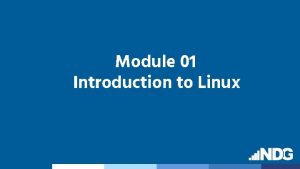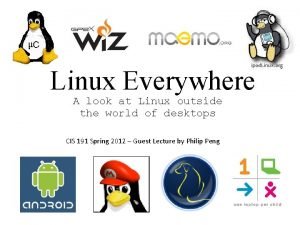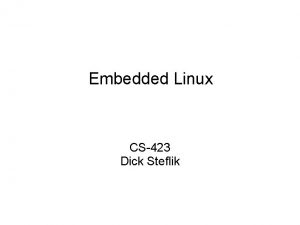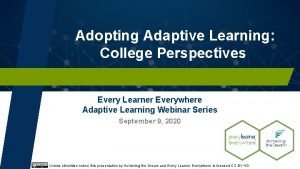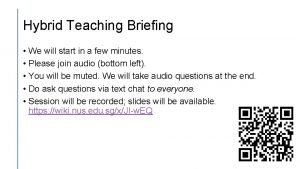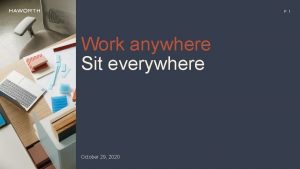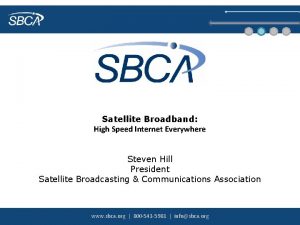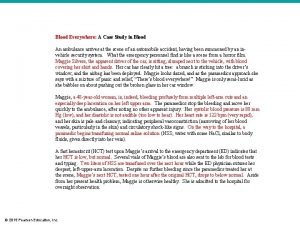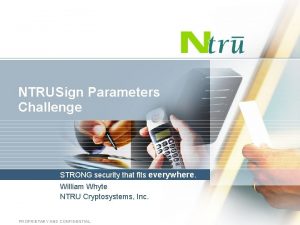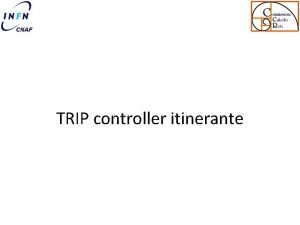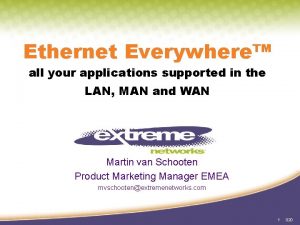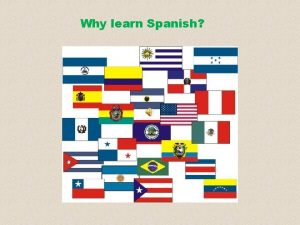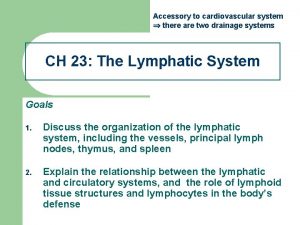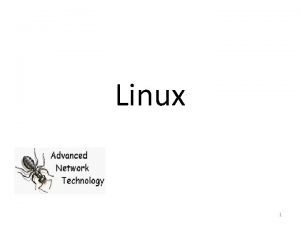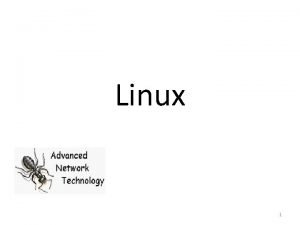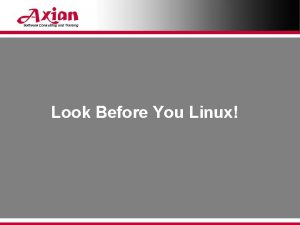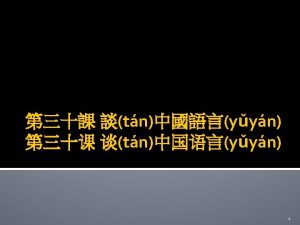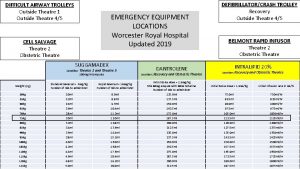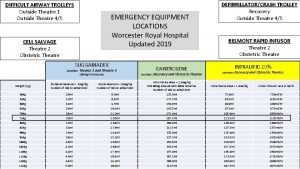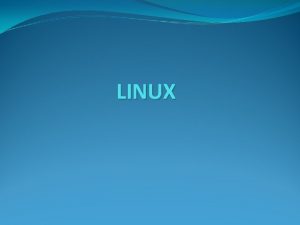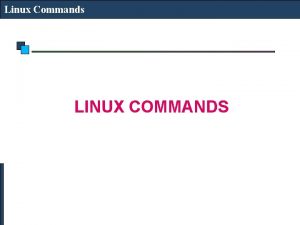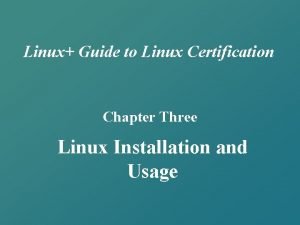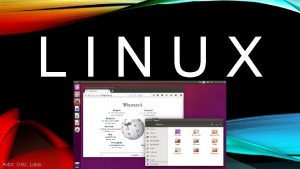Linux Everywhere A look at Linux outside the











































- Slides: 43

Linux Everywhere A look at Linux outside the world of desktops CIS 191 Spring 2012 – Guest Lecture by Philip Peng

Lecture Outline 1. 2. 3. 4. 5. 6. Introduction Different Platforms Reasons for Linux Cross-compiling Case Study: i. Pod. Linux Questions 2

What’s in common? 3

All your hardware belong to us • Linux is everywhere If its programmable, you can put Linux on it! – Yes, even a microwave – CES 2010, microwave running Android: http: //www. handlewithlinux. com/linux-washing-cooking 4

Servers • What servers use Stability, security, free – Examples: – ◦ Cent. OS ◦ Debian ◦ Red Hat 5

Desktop • What you use Free Windows/Mac alternative – Examples: – ◦ Ubuntu ◦ Fedora ◦ PCLinux. OS 6

Gaming Devices • What (white-hat) hackers do To run “homebrew” software – Examples: – ◦ ◦ ◦ PS 3, Wii, XBOX PS 2, Game. Cube Dreamcast PSP, DS Open Pandora, GP 2 X 7

Mobile Devices • What distributors are developing Community contribution – Examples – ◦ Android ◦ Maemo/Mee. Go/Tizen ◦ Openmoko 8

Embedded Devices • What embedded hardware run Small footprint, dev tools – Examples – ◦ RTLinux (real-time) ◦ μClinux (no MMU) ◦ Ångström (everything) 9

Why? 10

Free! • Free! As in freedom, i. e. open source – As in beer, i. e. vs paid upgrades – 11

Homebrew! • Run own software – Your hardware your software? 12

Support! • Community contribution “For the greater good” (i. e. users) – Everyone contributes – ◦ Specialists from all over the world – Existing hardware support ◦ Many already supported computer architecture ◦ Modify existing drivers 13

Lots of support! 14

Why not? • Because we can – If its hackable, it can run Linux 15

How? • How do we get Linux running on XXX? • Port: A version of software modified to run on a different target platform The PS 3 port of Fedora is a modified build of Fedora compiled to run on the PS 3 architecture – e. g. “I ported the Linux kernel to my i. Pod” – 16

Cross-compiling! • Supported hardware? Easy! Cross-compile! • Compiler: A program that converts code to an executable program for your computer • Cross-compiler: A program that converts code to an executable program for another platform 17

Cross-compiling! • What makes this possible? C and gcc C programming language is made to be easily portable to different architectures – The Linux kernel and all basic tools are written in C – Same source code runs of all sorts of platforms – 18

Multiple Compilers • “arm-elf” is the architecture that runs ELF executables (default format for Linux) on an ARM processor • μClinux is a Linux kernel fork for microcontrollers without a MMU (memory management unit) 19

Compiling for LFS (i 368 Linux) • Compiling tar for LFS (you did this for HW!) # wget http: //ftp. gnu. org/gnu/tar 1. 26. tar. bz 2 # tar -xf tar-1. 26. tar. bz 2 # cd tar-1. 26 #. /configure # make 20

Compiling for arm-elf • Compiling tar for arm-elf architecture # wget http: //ftp. gnu. org/gnu/tar 1. 26. tar. bz 2 # tar -xf tar-1. 26. tar. bz 2 # cd tar-1. 26 #. /configure CC=arm-elf-gcc LDFLAGS=-elf 2 flt –-host=arm-elf # make 21

Compiling for arm-elf • #. /configure CC=arm-elf-gcc LDFLAGS=elf 2 flt –-host=arm-elf • CC=arm-elf-gcc – Specify the “cross-compiler” to be used • LDFLAGS=-elf 2 flt Set any special linking flags (e. g. target specific) – In this case, convert ELF to b. FLT format – • --host=arm-elf – Specify the host machine that you are building for 22

Compiling for arm-elf • Result: • Native tar is in ELF format, cross-compiled is b. FLT format • Native tar can execute, cross-compiled tar can’t (not on the build computer at least) 23

Cross-compiling Terminology • Note on compiling terms: build, host, target • Build: platform that you are building on – Usually unspecified (since almost always Linux) • Host: platform that you are building for – For cross-compiling, e. g. arm-elf architecture • Target: machine that you are building for – For cross-compiling, only specified for special cases with different output formats 24

That was easy! • Review: To cross-compile Linux for a supported platform, just add a few config flags, and run make! • That was easy! = 25

But wait, there’s more! • But what happens if you want to run Linux on an unsupported platform? • Too bad, you’ll have to port it yourself! = 26

Porting Linux = Hard • Porting Linux in a nutshell: 1. 2. 3. 4. 5. Gather as much information about the hardware Reverse-engineer any currently existing software Modify the cross-compiling tools to generate binaries compatible with the new architecture Modify the kernel source code to support communicating with the various hardware components LFS all-over-again! (Except it probably won’t work the first time, or even the second) 27

Porting Linux = Hard • Porting Linux minimum requirements: – – – – C programming Linux (CIS 191) Compilers (CIS 341) OS concepts (CIS 380) Computer architecture (CIS 501) Experience with hardware debugging (e. g. JTAG) In-depth knowledge of the assembly language of the target architecture (e. g. x 86, ARM, MIPS, etc. ) 28

Why bother? 29

So you can do this 30

Case Study: i. Pod. Linux 31

What is i. Pod. Linux • i. Pod. Linux = i. Pod + Linux Custom port of μClinux to the old i. Pod hardware – Goal to turn your i. Pod into more than just an MP 3 player – Real reason: Because we can! – Wiki: http: //ipl. derpapst. eu IRC: #ipodlinux@irc. freenode. net Code: http: //sourceforge. net/projects/ipodlinux/ – 32

The Features - Software • • • Customizable user interface File-browser and plugin support Music player w/ OGG & FLAC support Video playback with sound Many user-ported Linux applications and emulators 33

The Features - Hardware • • • Custom graphical bootloader Playback of audio with piezo (scroll “clicker”) Audio-recording via headphone jack Backlight brightness control Overclocking CPU to 80 MHz (vs Apple’s 66 MHz) 34

My contribution • Joined official dev team in 2008 – – – Free i. Pod gift? Lets hack it! Sansa e 200 kernel patches podzilla 2 features + bug fixes Experimental kernel builds Compiling tutorials + tools Wiki and forum maintenance • See http: //ipl. derpapst. eu/wiki/User: Keripo 35

My contribution • Project Zero. Slackr Custom, non-destructive i. PL installation system – Ported numerous third part applications: – ◦ igp. SP – Gameboy Advanced emulator ◦ h. Doom – original Doom video game ◦ h. Wolf 3 D – original Wolfenstein 3 D ◦ … and much more • See http: //sourceforge. net/projects/zeroslackr/ 36

Compiling i. Pod. Linux • I wrote a i. Pod. Linux-from-Scratch tutorial! Pre-built dev environment (2. 95. 3 & 3. 4. 3 toolchains) – Compile podzilla 2 GUI + libraries (TTK, hotdog, zlib) – Compile ipodloader 2 bootloader – Patch and compile 2. 4. 32 u. Clinux kernel – • Alternative: use Zero. Slackr Entire build script system set up – Just run “build-all. sh” and wait ~3 hrs – • See http: //ipl. derpapst. eu/wiki/Introduction_to_Compiling_for_i. Pod. Linux 37

History Bit: Reverse Engineering • Problem: No source code/documentation • Solution: Reverse engineer it! Software not encrypted, can be dumped through hardware means – Apple left in a Diagnostic Mode – i. Pod. Linux project goes live in 2003 – More: http: //web. archive. org/web/20070224164831/http: //www. ipodlinux. org/blog/ 38

History Bit: Piezo Hack • Problem: Can’t dump i. Pod 4 G bootloader • Solution: Record it bit-by-bit! Use the piezo (“clicker”) to read the bootloader code as sound – Put i. Pod in sound-proof chamber – Leave i. Pod on overnight, decode the audio recording the next day – More : http: //web. archive. org/web/20070519081643/http: //www. ipodlinux. org/stories/piezo/39

History Bit: We had video first! • Problem: Still pictures on Apple’s new i. Pod Photo is boring, 2005 • Solution: Lets add video support! Uncompressed, 15 fps, A/V issues – Apple responds a year later with the i. Pod 5 G, the “i. Pod video” ; ( – We did it first! Still counts! – More : http: //ipl. derpapst. eu/wiki/Video_Player 40

History Bit: Nanotron 3000 • Problem: i. Pod nano 2 G encrypted, 2006 • Solution: Find an exploit! Buffer overflow in Notes functionality (no bound check beyond 268 chars in <a href> links) – Use LEGO Mindstorm to bruteforce the jump address location – More : http: //www. freemyipod. org/wiki/Nanotron_3000 41

History Bit: i. Phone • Problem: Apple releases i. Phone and i. Pod Touch in 2007 • Solution: None, it was a good run ; ( – Go work on other cool projects! – davidc (David Carne) worked on jailbreakme. com – Ari. X (Ari Weinstein) worked on i. Jailbreak – I work on Android and TA this course (Linux!) More: http: //www. tuaw. com/2007/10/29/instant-jailbreak-for-iphone-and-ipod-touch/ More: http: //online. wsj. com/article/SB 124692204445002607. html 42

Questions? 43
 Everywhere you go everywhere you look
Everywhere you go everywhere you look Look up and to the left
Look up and to the left Linux is everywhere
Linux is everywhere Linux everywhere
Linux everywhere Linux linux security module m1 support
Linux linux security module m1 support Uclinux
Uclinux Look at activity 1 and write
Look at activity 1 and write Activity 1 look up look down
Activity 1 look up look down Activity 1 image
Activity 1 image Getting started with poll everywhere
Getting started with poll everywhere Taoism philosophy
Taoism philosophy Clil water
Clil water Is everywhere an adverb of place
Is everywhere an adverb of place Every learner everywhere
Every learner everywhere Nus cit
Nus cit Sitting anywhere at work
Sitting anywhere at work Internet everywhere 2017
Internet everywhere 2017 3 formed elements in blood
3 formed elements in blood I'm singing for my lord everywhere i go lyrics
I'm singing for my lord everywhere i go lyrics Mercy bears richer fruits than strict justice
Mercy bears richer fruits than strict justice Literal sense in hrm
Literal sense in hrm English is everywhere
English is everywhere Unit 11 water water everywhere
Unit 11 water water everywhere Security that fits everywhere
Security that fits everywhere Trips everywhere 1
Trips everywhere 1 Every learner everywhere
Every learner everywhere Slogan it's everywhere you want to be
Slogan it's everywhere you want to be Data data everywhere and not a thought to think
Data data everywhere and not a thought to think Than almost everywhere
Than almost everywhere On demand everywhere
On demand everywhere Men pray everywhere
Men pray everywhere Chemistry is everywhere
Chemistry is everywhere Ethernet everywhere
Ethernet everywhere Educational excellence everywhere
Educational excellence everywhere Everywhere in spanish
Everywhere in spanish How can brahman be everywhere and in everything
How can brahman be everywhere and in everything It's just everywhere
It's just everywhere Ssl everywhere
Ssl everywhere Class 8 english chapter 7 water water everywhere
Class 8 english chapter 7 water water everywhere Signs signs everywhere signs meaning
Signs signs everywhere signs meaning Lymphatic vessels are located everywhere except the
Lymphatic vessels are located everywhere except the I go everywhere you go
I go everywhere you go Elements of poerty
Elements of poerty I've been everywhere canada
I've been everywhere canada


